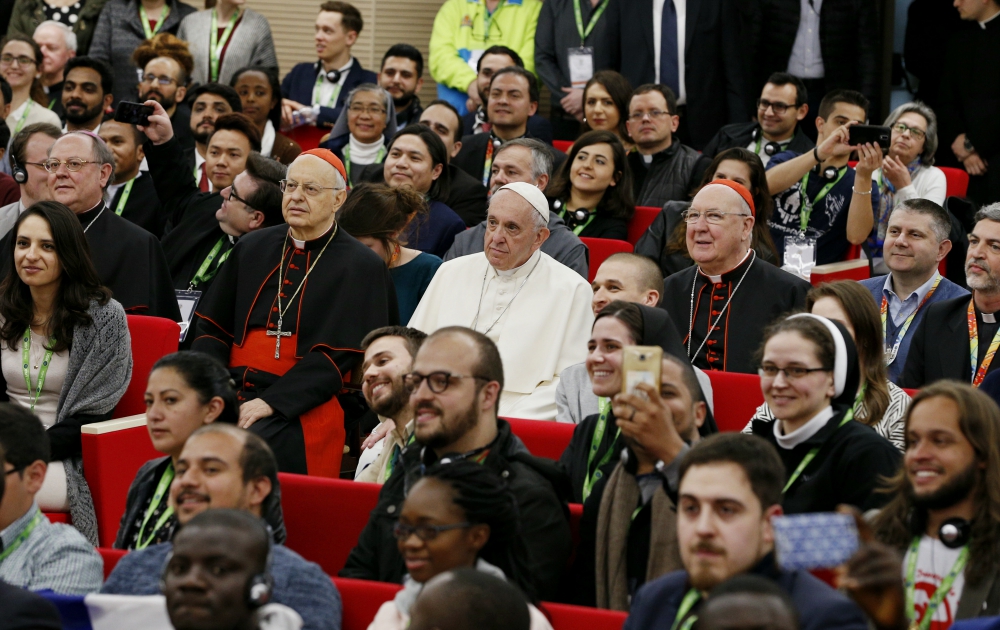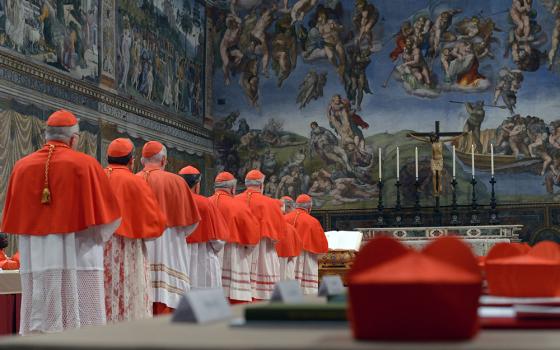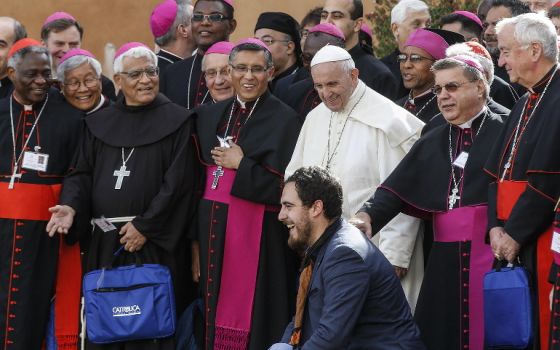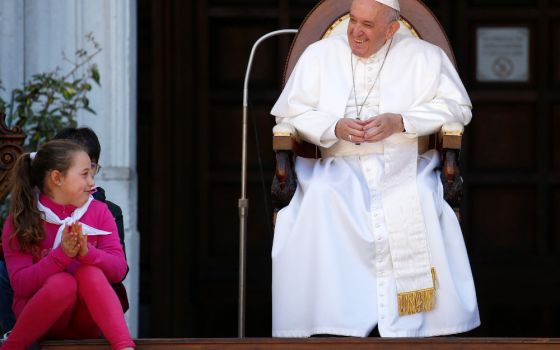
Cardinal Lorenzo Baldisseri, secretary-general of the Synod of Bishops, Pope Francis and Cardinal Kevin Farrell, prefect of the Dicastery for Laity, the Family and Life, pose for a photo during a pre-synod gathering of youth delegates in Rome March 19. (CNS/Paul Haring)
As the church worldwide recoils at the renewed wave of sexual abuse, several hundred bishops will soon gather in Rome to talk about young people. The optics are not good.
Don't get me wrong. Of the voting members, most — if not all — are upstanding men. Only one is currently under indictment. But, like water dripping on a stone, the same story — from Chile, from the Netherlands, from the United States, with variations on the theme from India and Africa — is wearing people's patience thin.
But the Fifteenth Ordinary General Assembly of the Synod of Bishops on Young People, the Faith and Vocational Discernment will go on, this time with a new playbook. Pope Paul VI created the Synod of Bishops in 1965. Pope Francis just updated its procedures and made it a permanent structure with his apostolic constitution Episcopalis Communio. It's time.
The new synod process expands discussion, first allowed under Pope Benedict XVI. The objective is to gain what Episcopalis Communio calls "moral unity" in acceptance of a final synod document, which could become part of the ordinary magisterium — the official teaching of the church — if Francis approves it.
As for who will create the document, most voting delegates are bishops. The group representing men religious is sending two brothers — laymen — among its 10 voting delegates (they broke the rules last time and the time before by electing lay brothers and nobody complained.)
But the women's International Union of Superiors General was not invited to send voting delegates, even though non-bishops can be and are included. Specifically, "others who are not honored with episcopal duties can be called to the synod assembly."
According to Bishop Fabio Fabene, undersecretary of the Synod of Bishops, "As for women, they are already present as observers and participate in the synodal assembly and the small groups and have a right to speak."
What a breakthrough! Women allowed to speak!
Male religious superiors who are not bishops (including, remember, two lay brothers) are voting members. Can the authority of female religious superiors, especially the abbesses of territorial abbeys, not be recognized?
In medieval times, territorial abbesses had equivalent rights to secular bishops. One, the Cistercian abbess of the 12th-century Royal Abbey of Las Huelgas in Spain, had only the pope as religious superior. For seven centuries, she, not the local bishop, granted sacramental faculties. Pope Pius IX quashed hers and others' authority and jurisdiction in 1874. Certainly, up to the Council of Trent, and even longer, some abbesses in Sweden, France and Italy were similarly powerful.
Advertisement
To be fair, it is a Synod of Bishops, this time to discuss what to do about young people. They already have input. The synod website included multilingual questionnaires aimed at its target group: people 16-29 years of age. Each bishops' conference collated local responses and provided a report. In the U.S., 100 of 194 dioceses, 25 Catholic organizations, and several bishops' conference committees participated. The international mélange eventually produced the synod's instrumentum laboris — its working document.
The working document notes that the synod's March 2018 preliminary meeting, at which young people were able to voice their opinions, found great distance between what the church says and what the church does. It states that the preliminary meeting "gave specific attention to forms of discrimination impacting young women" including in the church. "Therefore," it continues, "young people ask themselves 'what are the places where women can flourish within the Church and society?' "
Translation: The young members asked, what's the point? Women have no place in the Catholic Church.
It's getting old. In the 19th century, Pius IX tightened the clerical vise on laypeople and especially on women. By the turn of the 20th century, the last two lay cardinals died, and successive Codes of Canon Law legislated that cardinals — papal advisers — had to be priests (1917) and then bishops (1983).
For the synod to bring hope to the people of God, it must include findings that will help Francis give more authority to women. Otherwise, the negative optics will overcome any statement the synod makes.
[Phyllis Zagano is senior research associate-in-residence at Hofstra University in Hempstead, New York. Her books include Women Deacons: Past, Present, Future (recently published in Canada as Des femmes diacres) and Holy Saturday: An Argument for the Restoration of the Female Diaconate in the Catholic Church.]
Editor's note: We can send you an email alert every time Phyllis Zagano's column, Just Catholic, is posted. Go to this page and follow directions: Email alert sign-up.









